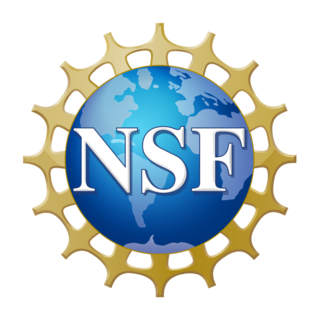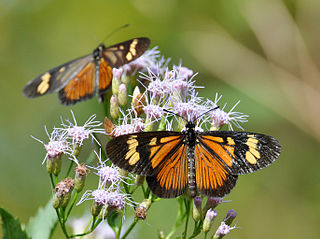
Genus is a taxonomic rank above species and below family as used in the biological classification of living and fossil organisms as well as viruses. In binomial nomenclature, the genus name forms the first part of the binomial species name for each species within the genus.

The U.S. National Science Foundation (NSF) is an independent agency of the United States federal government that supports fundamental research and education in all the non-medical fields of science and engineering. Its medical counterpart is the National Institutes of Health. With an annual budget of about $9.9 billion, the NSF funds approximately 25% of all federally supported basic research conducted by the United States' colleges and universities. In some fields, such as mathematics, computer science, economics, and the social sciences, the NSF is the major source of federal backing.

The Heliconiinae, commonly called heliconians or longwings, are a subfamily of the brush-footed butterflies. They can be divided into 45–50 genera and were sometimes treated as a separate family Heliconiidae within the Papilionoidea. The colouration is predominantly reddish and black, and though of varying wing shape, the forewings are always elongated tipwards, hence the common name.

Actinote is a genus of butterflies from South America of the subfamily Heliconiinae in the family Nymphalidae. Males interact with or without physical contact to contest the possession of mating sites. The winner in such interactions often has larger body size and is the individual that previously occupied the territory.

Acraea is a genus of brush-footed butterflies of the subfamily Heliconiinae. It seems to be highly paraphyletic and has long been used as a "wastebin taxon" to unite about 220 species of anatomically conservative Acraeini. Some phylogenetic studies show that the genus Acraea is monophyletic if Bematistes and Neotropical Actinote are included. Most species assembled here are restricted to the Afrotropical realm, but some are found in India, Southeast Asia, and Australia.
Eremochlaena is a genus of moths of the family Noctuidae, first described by Charles Boursin in 1953. The type species is Eremochlaena oranaLucas, 1849.

Acraea bonasia, the bonasia acraea, is a butterfly in the family Nymphalidae which is native to the African tropics and subtropics.
Acraea burgessi is a butterfly in the family Nymphalidae. It is found in Uganda (Kigezi) and the Democratic Republic of the Congo.

Acraea necoda is a butterfly in the family Nymphalidae. It is found on the central and northern plateau in Ethiopia.

Actinote thalia is a butterfly of the family Nymphalidae. It was described by Carl Linnaeus in the 1758 10th edition of Systema Naturae. It is found in most of South America. An attempt was made by the South African programme to defoliate the Chromolaena odorata, a shrub of Neotropical origin, by this species, but was disqualified due to an unacceptably wide host range.

The Interim Register of Marine and Nonmarine Genera (IRMNG) is a taxonomic database which attempts to cover published genus names for all domains of life, from 1758 in zoology up to the present, arranged in a single, internally consistent taxonomic hierarchy, for the benefit of Biodiversity Informatics initiatives plus general users of biodiversity (taxonomic) information. In addition to containing just over 500,000 published genus name instances as at May 2023, the database holds over 1.7 million species names, although this component of the data is not maintained in as current or complete state as the genus-level holdings. IRMNG can be queried online for access to the latest version of the dataset and is also made available as periodic snapshots or data dumps for import/upload into other systems as desired. The database was commenced in 2006 at the then CSIRO Division of Marine and Atmospheric Research in Australia and, since 2016, has been hosted at the Flanders Marine Institute (VLIZ) in Belgium.
Haruchlora is a genus of butterflies belonging to the family Geometridae.
Lestonia is a genus of true bugs belonging to the monotypic family Lestoniidae.

Glaucopsyche astraea is a species of butterfly in the family Lycaenidae. The species can be found throughout Turkey. The species has one subspecies:
Onychoteuthis prolata is a species of squid in the family Onychoteuthidae. They can be found in the Eastern Pacific Ocean off the coast of Hawaii, and can grow to 15.5 centimeters in length.

Actinote pellenea is a species of butterfly of the genus Actinote. Fully-grown adults can have a maximum wingspan of ~50-58 millimeters.

Actinote parapheles is a species of butterfly of the genus Actinote. The species has a maximum wingspan of ~55 millimeters.

Actinote stratonice is a species of butterfly of the genus Altinote.

Actinote zikani is an extremely rare species of butterfly belonging to the family Nymphalidae, the subfamily Heliconiinae and the genus Actinote, endemic to Brazil. Its typical habitat is the Brazilian Atlantic forest at approximately 1,000 meters altitude, in the Serra do Mar. Considered extinct after 1981, the species was rediscovered in 1991 in the state of São Paulo, in the southeast of the country.













